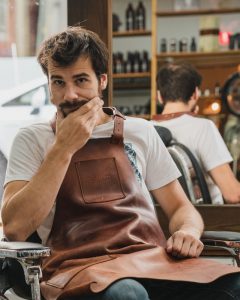 It was a “cocktail of difficult events” over the past three years that led Noé Talbot to his current album, Remercier les accidents. All the obstacles, from anxiety to the pitfalls of an over-crowded schedule, were layered on top of each other, and then accidents, choices, forced rest, and unexpected new beginnings, gave birth to the post-storm music. Music for which we’re thankful.
It was a “cocktail of difficult events” over the past three years that led Noé Talbot to his current album, Remercier les accidents. All the obstacles, from anxiety to the pitfalls of an over-crowded schedule, were layered on top of each other, and then accidents, choices, forced rest, and unexpected new beginnings, gave birth to the post-storm music. Music for which we’re thankful.
“I had never had anxiety in my life, and all of a sudden I couldn’t leave my house for several days, as if I were paralyzed. I had burned the candle at both ends,” says Talbot, now resigned to choosing his battles. “I was working on my teaching degree, I had a girlfriend in France, and lots of musical projects,” he says. “I’ve always been the ‘Where there’s a will there’s a way’ type, but my body just couldn’t keep up.”
With a nodule on one of his vocal cords, teaching by day and singing by night, Talbot realized that choices had to be made. “Between teaching and music, I chose music,” he says. “I healed from that nodule and took time for myself. That made me a lot more human, and sensitive to psychological distress.”
When it was time to record his album, an administrative glitch between his musicians and his label forced him to change his plans. “I was forced to hire session musicians,” he explains. “I used three different producers. I was outside of my comfort zone, and had to pay more attention to myself since I was now the only common thread between all the elements of the project.”
For him, the toughest thing about changes and breaks is accepting them. Hence the album’s title. “I’m thankful for all the bumps in the road,” he now readily admits. “We’re always pushing back against the frantic pace of life, the storm, the tornado, and we end up forgetting to accept it, which is the key. Hitting rock bottom is not that important. As long as you accept that you hit rock bottom,” he adds with a laugh.
Accidents are no strangers to Talbot’s creative process. “I firmly believe in the adage that constraints feed creativity,” he says. “I try to write pretty much every day, and I like to dabble in different styles and genres.” Globally, it’s something the listener notices almost immediately, because all of his songs are extremely different from one another.
“Some artists are more at ease with uniformity. I would feel uncomfortable. I want songs to have a soul,” he says. Hence his insistence on experimenting with various writing styles. Songs will therefore begin as an a capella, on the piano, on the guitar, in the studio, or in the shower, from a fragment of melody, or a sentence he decided to dwell on a little longer. “Creativity is a muscle,” he believes. “I do crossword puzzles, I use various techniques to diversify my vocabulary.”
Beyond that intense effort to never get stuck in an overly-familiar method, there’s pressure. “The best ally of creativity is getting rid of pressure,” Talbot says adamantly. “I’m lucky enough that my projects are successful. Not incredibly so, but I have fans that like everything I do, whether I’m punkier or softer. My next album will be very soft, and I gave myself that freedom – going back to soft things, if that’s what I feel like doing.”
Achieving a goal with a song isn’t magic, but Talbot knows at least part of the recipe: “Creating a hit is 70 percent marketing and 30 percent touching people’s souls at the same time you touch your own. You have to put part of yourself into it,” he says. At that stage of the creative process, the only way to succeed, to him, is to create a lot. If it takes 100 songs to write just one that stands out, then so be it.
Talbot inhabits his own creative process as much as he wishes to understand and de-mystify that of others. That’s the reason why he produced the podcast Main d’oeuvre alongside Philippe Vaillancourt. “With each artist we welcome, we tell each other stories from the studio, we go into detail about the lyrics of the songs, and we understand the authenticity of each person who makes a song,” he says. Talbot hopes to learn and share the experiences of others: “A successful artist is almost always an artist who knows that authenticity led them to their best work.”